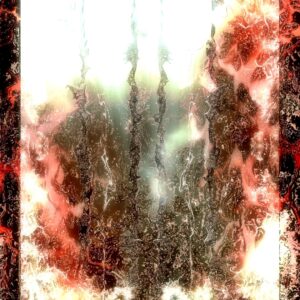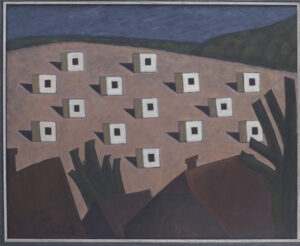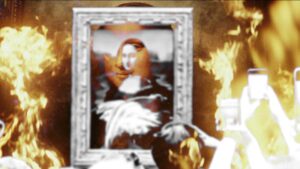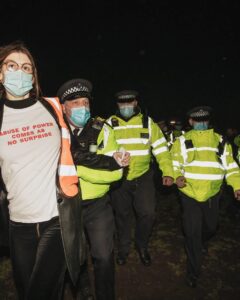We understand the world better if we tremble with it.
– Édouard Glissant
In 2018, The Drawing Center staged a works on paper exhibition exploring the horizons of knowable subjects. For Opacity: Elijah Burgher, Toyin Ojih Odutola, and Nathaniel Mary Quinn drew its inspiration from Martiniquan philosopher Édouard Glissant’s 1990 essay, “For Opacity,” in which Glissant discusses his theory of Relationality, or the multiplicity of relations between subjects in and through retainable and recognizable difference.[1] Leaning on Glissant, chief curator Claire Gilman positioned the exhibition as an argument interested in the “right to refuse self-revelation and classification. It is a show about the right to not be understood and still demand respect; to take one’s place in the world and simply be.”[2] Each of the three artists explored how the act of drawing a subject presumes the possibility of knowing said subject, or, indeed, what it means to make subjects knowable through their figural form, and then to refuse full access to this knowledge. For Burgher, drawing precipitates control, or the semblance of it, the chance to “possess…a person by making a forceful representation of them”[3]; for Ojih Odutola, “mark-making” becomes a way to make viewers “adjust themselves to me instead of the other way around”[4]; while for Quinn, collaged portraits carry no secret “‘clue’ that unlocks the puzzle [of knowing the subject they make up]. They just exist. They possess the right to exist.”[5]
The hierarchy of relations introduced through these artists’ figurative drawings recalls the social relations of the empathetic encounter, defined here as the invocation to imagine ourselves in another’s place. As inherited from Enlightenment ideas of sympathy, the political dimensions empathy, assumes the possibility of being transparently known, of being available to be known and reduced into terms that can be consumed and imagined by others—to render a portrait as a portal through which one projects the self into another place, an imaginative leap forward. It is precisely this act of projection and knowable possession that raises concerns for how empathetic acts are leveraged in the engineering of social relationships, particularly between minoritarian and majoritarian subjects. Empathy uncritically leveraged points to how the literal exchange and exploitation of minoritarian subjects in the form of slavery, colonialism, and imperialism generated questions of freedom, citizen, and ethics, while precluding any possibility of these subjects’ own entrance into such dialogues.[6] One important critique comes from Saidiya Hartman’s citation of Jonathan Boyarin’s concept of empathy as a hegemonic ethic.[7] Boyarin theorizes that empathy unchecked operates by way of a forced “obliteration of Otherness,” where the “feel[ing] ourselves into”[8] the place of the Other replicates and subsumes a dialectical power structure rather than recognize a unpossessable positionality—the right to exist in difference.
What might be found in an empathetic encounter that does not make space for an occupying projection? What of the image of the Other that is incomplete, and by its incompletion, works not to know the Other’s position or experience in order to inform one’s own, but to dwell in what is unknown? Indeed, Glissant reminds us that Relationality is not a proposal of dissolution of difference; of residing, meeting, or merging only in the space between singularities; or of rationalizing another scheme for ordering the knowable world. Rather, if Relationality makes possible the fabrication of a non-hierarchical world, then Opacity is the recognition of its non-hierarchical textures—textures that are felt through the intermingling of incongruent differences, an incomplete imaged Other whose lines, marks, and impressions leave the surface of the distance between known and unknown as distinct as the weft and weave of a woven fabric. As Glissant writes:
Opacities can coexist and converge, weaving fabrics. To understand these truly one must focus on the texture of the weave and not on the nature of its components. For the time being, perhaps, give up this old obsession with discovering what lies at the bottom of natures. There would be something great and noble about initiating such a movement, referring not to Humanity but to the exultant divergence of humanities. Thought of self and thought of other here become obsolete in their duality. Every Other is a citizen and no longer a barbarian. What is here is open, as much as this there. I would be incapable of projecting from one to the other. This-here is the weave, and it weaves no boundaries.[9]
For Opacity sees the surface of the figured subject a screen that both reveals and “necessarily withholds,”[10] by making the portrait an already distinct zone of self-possessed knowing. Here, to image the subject, rather than translate a figurative representation, and thus assume the possibility of such translation, instead questions what it means to intervene, interrupt, circumvent, deny, and frustrate knowing—to leave the textures of our selves visible, to refuse submission and reduction, to remain unknowable, even where felt. Here is a visualization of Relationality that preserves textures of difference within the aesthetic encounter, describing a relationship between knowing and unknowing that does not reduce the possessable knowledges that can come to pass between, but opens fluid dialogue. Opacity does not assume ready, willing, or given access in terms of the encounter between singularities, but nor does it deny the meeting of singularities. Opacity, rather, nurtures entanglement.
To question the work of empathy, or, rather, what work empathy does in making sense of aesthetic forms and ways of life, is to wrest to the surface of sentimental rhetoric that which would implicate us not merely to each other’s pain, but to each other’s survival. The empathetic encounter, as a right to opacity, becomes a site of fabrication, a presentation of a world view that reveals how relationships between bodies learn to feel, for whom, and towards what ends. This is the right to empathetic opacity: not a withholding of information, but, rather, a reframing of what knowledges, imaginations, and images of selves are permissible within the meeting of difference.
Notes
[1] Édouard Glissant. “For Opacity,” in Poetics of Relation, trans. Betsy Wing (Ann Arbor: The University of Michigan Press, 1997 [1990]), 189–190.
[2] Claire Gilman, “For Opacity: Elijah Burgher, Toyin Ojih Odutola, and Nathaniel Mary Quinn,” from For Opacity: Elijah Burgher, Toyin Ojih Odutola, and Nathaniel Mary Quinn (New York: The Drawing Center, 2018), 11.
[3] Elijah Burgher, “The Limits of Likeness,” from For Opacity: Elijah Burgher, Toyin Ojih Odutola, and Nathaniel Mary Quinn (New York: The Drawing Center, 2018), 27.
[4] Toyin Ojih Odutola, quoted in Shirley Nwangwa, “‘Mark-Making as a land Your Eyes Traverse’: Toyin Ojih Odutola Talks with Zadie Smith,” Artnews, December 6, 2018, http://www.artnews.com/2018/12/06/mark-making-land-eyes-traverse-toyin-ojih-odutola-conversation-zadie-smith/.
[5] Gilman, “For Opacity,” 16.
[6] For a critical study on these connections, see Lisa Lowe, The Intimacies of Four Continents (Durham: Duke University Press, 2015).
[7] For further discussion, see Saidiya Hartman, Scenes of Subjection: Terror, Slavery, and Self-Making in Nineteenth Century America (Oxford: Oxford University Press, 1997).
[8] Jonathan Boyarin, Storm from Paradise: The Politics of Jewish Memory (Minneapolis: The University of Minnesota Press, 1992), 8.
[9] Glissant, “For Opacity,” 190.
[10] The Drawing Center, “For Opacity: Elijah Burgher, Toyin Ojih Odutola, and Nathaniel Mary Quinn,” Drawing Papers 138, (2018): https://drawingcenter.org/bookstore/books/dp138-for-opacity.





